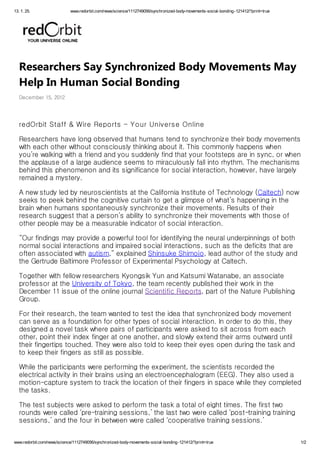
Researchers Say Synchronized Body Movements May Help In Human Social Bonding - Redorbit
- 1. 13. 1. 25. www.redorbit.com/news/science/1112749056/synchronized-body-movements-social-bonding-121412/?print=true Researchers Say Synchronized Body Movements May Help In Human Social Bonding December 15, 2012 redOrbit Staff & Wire Reports – Your Univers e Online Researchers have long observed that humans tend to synchronize their body movements with each other without consciously thinking about it. This commonly happens when you’re walking with a friend and you suddenly find that your footsteps are in sync, or when the applause of a large audience seems to miraculously fall into rhythm. The mechanisms behind this phenomenon and its significance for social interaction, however, have largely remained a mystery. A new study led by neuroscientists at the California Institute of Technology (Caltech) now seeks to peek behind the cognitive curtain to get a glimpse of what’s happening in the brain when humans spontaneously synchronize their movements. Results of their research suggest that a person’s ability to synchronize their movements with those of other people may be a measurable indicator of social interaction. “Our findings may provide a powerful tool for identifying the neural underpinnings of both normal social interactions and impaired social interactions, such as the deficits that are often associated with autism,” explained Shinsuke Shimojo, lead author of the study and the Gertrude Baltimore Professor of Experimental Psychology at Caltech. Together with fellow researchers Kyongsik Yun and Katsumi Watanabe, an associate professor at the University of Tokyo, the team recently published their work in the December 11 issue of the online journal Scientific Reports, part of the Nature Publishing Group. For their research, the team wanted to test the idea that synchronized body movement can serve as a foundation for other types of social interaction. In order to do this, they designed a novel task where pairs of participants were asked to sit across from each other, point their index finger at one another, and slowly extend their arms outward until their fingertips touched. They were also told to keep their eyes open during the task and to keep their fingers as still as possible. While the participants were performing the experiment, the scientists recorded the electrical activity in their brains using an electroencephalogram (EEG). They also used a motion-capture system to track the location of their fingers in space while they completed the tasks. The test subjects were asked to perform the task a total of eight times. The first two rounds were called ‘pre-training sessions,’ the last two were called ‘post-training training sessions,’ and the four in between were called ‘cooperative training sessions.’ www.redorbit.com/news/science/1112749056/synchronized-body-movements-social-bonding-121412/?print=true 1/2
- 2. 13. 1. 25. www.redorbit.com/news/science/1112749056/synchronized-body-movements-social-bonding-121412/?print=true For the cooperative training sessions, the scientists selected one person at random to act as the leader. This participant was asked to perform a series of large finger movements and the others were told to follow these movements with their own fingers. When the team analyzed the data recorded by motion-sensor, they found that the subjects’ finger movements were significantly more synchronized during the post-training sessions compared to the pre-training sessions. Similarly, the EEG readings also showed a higher level synchronicity between the individual subjects’ brains during the post-training exercises, especially in regions of the brain related to social and sensorimotor activity. However, these social and sensorimotor regions were not more synchronized within each individual’s brain, but only between the brains of the different participants. The researchers say that their experiment provided a simple yet novel way to allow participants to interact on the subconscious level while minimizing movements that could otherwise distort the recording of their neural activity. “The most striking outcome of our study is that not only the body-body synchrony but also the brain-brain synchrony between the two participants increased after a short period of social interaction,” explained Yun. “This may open new vistas to study the brain-brain interface. It appears that when a cooperative relationship exists, two brains form a loose dynamic system.” The researchers went on to note that their study could eventually prove to be a useful tool for people looking to find compatible partners for romantic or even business relationships. “Because we can quantify implicit social bonding between two people using our experimental paradigm, we may be able to suggest a more socially compatible partnership in order to maximize matchmaking success rates, by preexamining body synchrony and its increase during a short cooperative session” explains Yun. The researchers also supplemented their experiment with a survey asking the participants to rank themselves for various social personality traits. They then compared the results of the questionnaires to each individual’s experimental results and found that there were a number of interesting correlations. For instance, the team noted that participants who said that they suffered from social anxiety also demonstrated the smallest improvement in synchronizing their body movements with others during the post-training phase. The team says that the next phase of their research will probably focus on finding out whether more complex social interactions – such as completing group projects or games – also causes an increase in the synchronicity of body movements. This, they believe, will help them get closer to understanding the exact mechanism behind synchronized body movement and social cohesion. “We may also apply our experimental protocol to better understand the nature and the neural correlates of social impairment in disorders where social deficits are a common symptom, as in schizophrenia or autism,” says Shimojo. www.redorbit.com/news/science/1112749056/synchronized-body-movements-social-bonding-121412/?print=true 2/2
